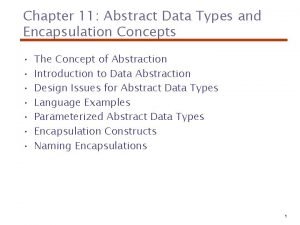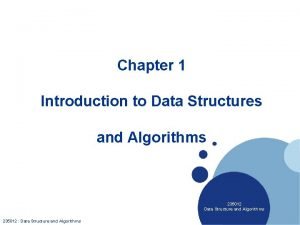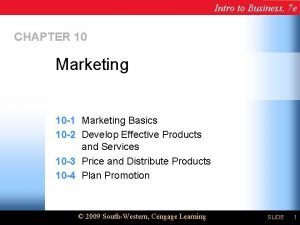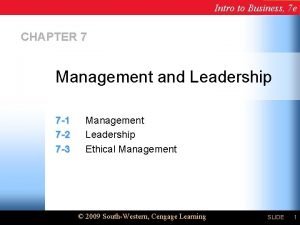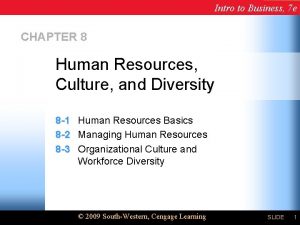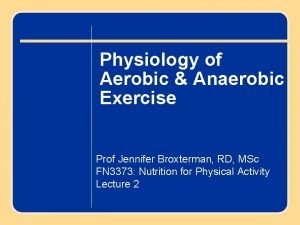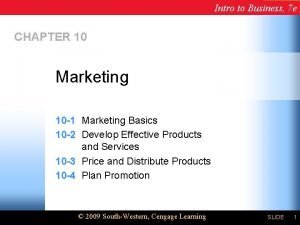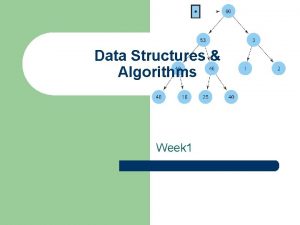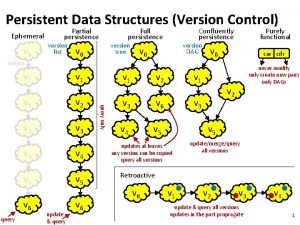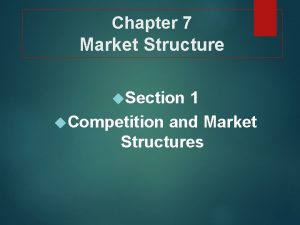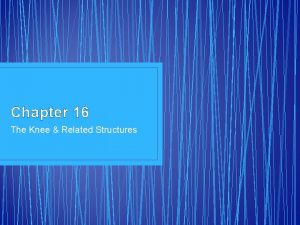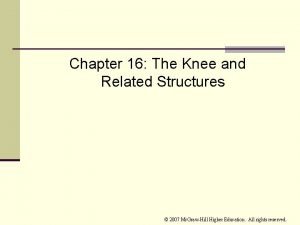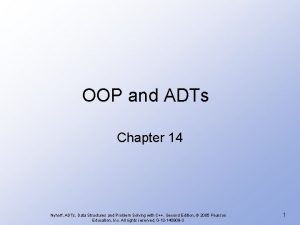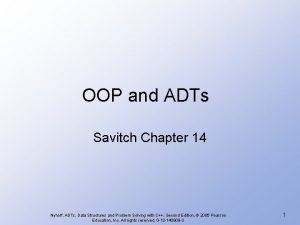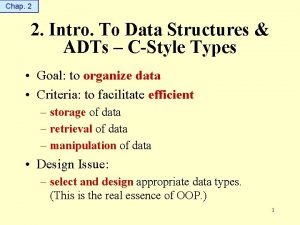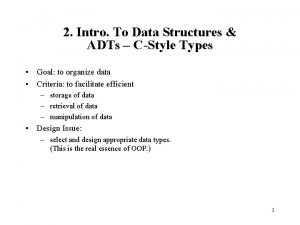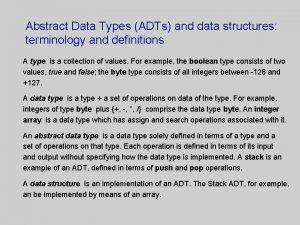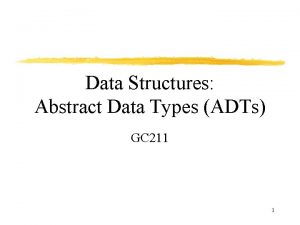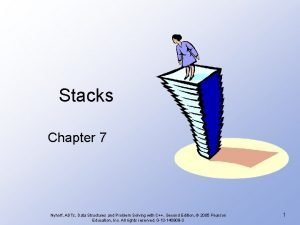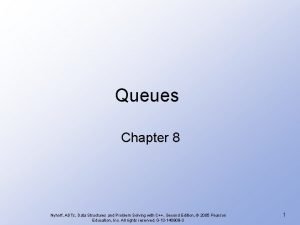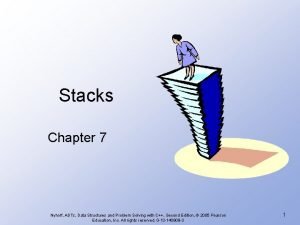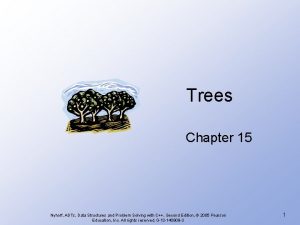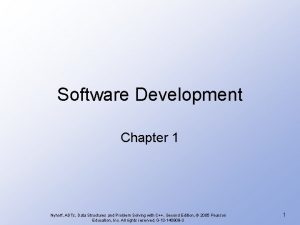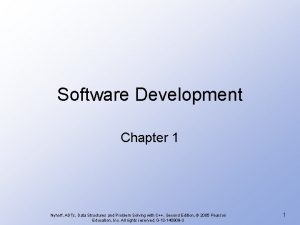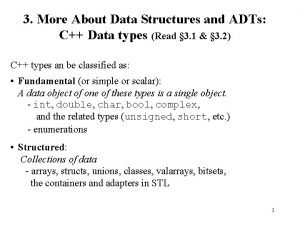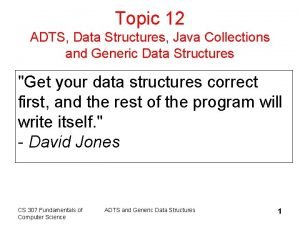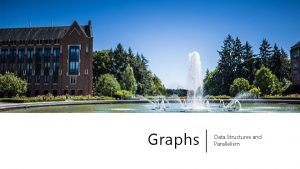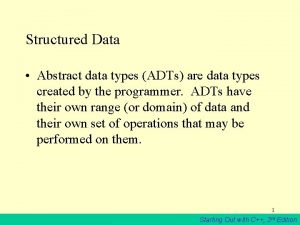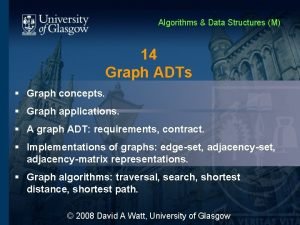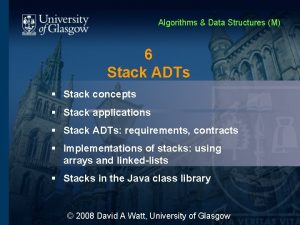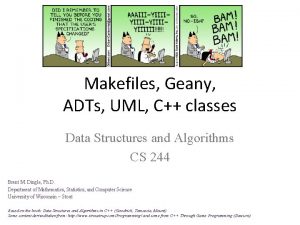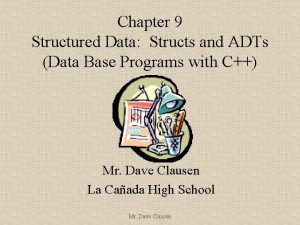Intro to Data Structures and ADTs Chapter 2























![C-Style Data Structures Arrays • Single dimension • Multi dimension int num. List [30]; C-Style Data Structures Arrays • Single dimension • Multi dimension int num. List [30];](https://slidetodoc.com/presentation_image_h2/7b387e3e28bf9bd82bbf3b6083d9a81e/image-24.jpg)








- Slides: 32

Intro to Data Structures and ADTs Chapter 2 1

Goal of Data Structures • Organize data • Facilitate efficient … – storage – retrieval – manipulation of data • Select and design appropriate data types • This is the real essence of OOP 2

Simplicity Tradeoff • Simplicity of data organization versus • Simplicity/elegance of algorithms • Simple (unsophisticated) data structure – may require much work for processing data. • More complex data organization – May yield nicer algorithms for the basic operations 3

Issues • Amount of data – phone book lookup (Hallsville vs. Dallas) – linear search? • Number of accesses and use required – compiler's lookup of an identifier's type in a symbol table – linear, binary, hash table? • Static vs. dynamic nature of the data – consider a text processor – array, vector? 4

Abstract Data Types (ADT) • Defn: collection of – related data items … together with – an associated set of operations • Why "abstract? " – Data, operations, and relations are studied independent of implementation. • What not how is the focus. 5

Implementation of an ADT • Defn: storage (data) structures which – store the data items … and – algorithms for the basic operations • These data structures are – provided in a language or – built from the language constructs (user defined) 6

Implementation of an ADT • Successful software design uses data abstraction • We separate the – definition of a data type – the implementation from 7

C++ Types 8

Memory • 2 -state devices « bits 0 and 1 • Organized into – bytes (8 bits) and – words (machine dependent — e. g. , 4 bytes). • Each byte (or word) has an address – to store and retrieve contents of any given memory location. 9

Simple Data Types • The most basic form of data sequences of bits • Simple data types – values are atomic — can't be subdivided – are ADTs. • Implementations have: – Storage structures: memory locations – Algorithms: system hardware/software to do basic operations. 10

Simple Data Types • Boolean – values { false, true } – could be stored in bits, usually use a byte – operations &&, || • Character – byte for ASCII, EBCDIC – 2 bytes for Unicode (Java) – operations ==, <, >, etc. using numeric code 11

Simple Data Types • Unsigned Integer data – non-negative unsigned integers – stored in base-two in a fixed number of bits • Signed integer – stored in a fixed number of bits • Representations – sign-magnitude – two's complement 12

Sign-magnitude Representation • Save one bit (usually most significant) for sign (0 = +, 1 = – ) • Use base-two representation in the other bits. ú 88 = 000001011000 ú -88 = 1 00001011000 Cumbersome for arithmetic computations 13

Two's Complement Representation • For nonnegative n: – Use ordinary base-two representation with leading (sign) bit 0 • For n < 0 1) Find w-bit base-2 representation of |n| 2) Complement each bit. 3) Add 1 14

Two's Complement Representation • Example: – 88 1. 88 as a 16 -bit base-two number 000001011000 2. Complement this bit string 111110100111 WHY? 3. Add 1 111110101000 15

Two's Complement Representation • Works well for arithmetic computations 5 + – 6: 0000000101 +1111111010 What gets done to 11111111 the bits to give this answer? 16

Biased Representation • Add a constant bias to the number – typically 2 w-1 (where w is number of bits) – then find its base-two representation • Example: 88 using w = 16 bits and bias of 215 = 32768 1. Add the bias to 88, giving 32856 2. Represent the result in base-two notation: 100001011000 17

Biased Representation • Example -88 using w = 16 bits and bias of 215 = 32768 1. Add the bias to -88, giving 32680 2. Represent the result in base-two notation: 011110101000 • Good for comparisons; so, it is commonly used for exponents in floating-point representation of reals. 18

Problems with Integer Representation • Limited Capacity — a finite number of bits • An operation can produce a value that requires more bits than maximum number allowed. This is called overflow. • None of these is a perfect representation of (mathematical) integers • Can only store a finite (sub)range of them. 19

Real Data • Types float and double in C++ • Use single precision (IEEE Floating-Point) • Store: ú sign of mantissa in leftmost bit (0 = +, 1 = – ) ú biased binary rep. of exponent in next 8 bits (bias = 127) ú bits b 2 b 3. . . b 24 mantissa in rightmost 23 bits. ú Need not store b 1 — know it's 1) 20

Real Data • Example: 22. 625 = 10110. 1012 • Floating point form: 1. 01101012 * 24 21

Problems with Real Representation • Exponent overflow and underflow • Round off error – Most reals do not have terminating binary representations. Example: 0. 7 = (0. 10110011001100. . . )2 22

Problems with Real Representation • Round off error may be compounded in a sequence of operations. – Recall the sums of calculated currency values • Be careful in comparing reals – with == and !=. – Instead use comparison for closeness if (abs (x – 12. 34) < 0. 001) … 23
![CStyle Data Structures Arrays Single dimension Multi dimension int num List 30 C-Style Data Structures Arrays • Single dimension • Multi dimension int num. List [30];](https://slidetodoc.com/presentation_image_h2/7b387e3e28bf9bd82bbf3b6083d9a81e/image-24.jpg)
C-Style Data Structures Arrays • Single dimension • Multi dimension int num. List [30]; float real. List [10]; int num. Table [3][4][5]; • All elements of same type • Elements accessed by – name and [ ] operator num. List[5] – name, offset, and dereference *(numlist + 5) • Name of the array is a pointer constant 24

Arrays • Arrays as parameters Note you must specify number of elements used – Formal parameter void do. It (int list[ ], int count); / or void to. It (int *list, int count); – Actual parameter doit (num. List, num. Used); Same call for either style of parameter list declaration 25

Problems with C-Style Arrays • Capacity cannot change. • Solution 1 (non-OOP) Later – Use a "run-time array" – Construct B to have required capacity – Copy elements of A into B – Deallocate A Solution 2 (OOP) Use vector 26

Problems with C-Style Arrays • Virtually no predefined operations for non-char arrays. • The Deeper Problem: – C-style arrays aren't self-contained. 27

Basic Principle of OOP: • An object should be autonomous (self-contained) • Should carry within itself all of the information needed to describe and operate upon itself. 28

Aggregate Data Types • Predefined types not always adequate to model the problem – When objects have multiple attributes – When objects have collections of heterogeneous elements • C++ provides structs and classes – Create new types with multiple attributes 29

Structures • Characteristics – has a fixed size – is ordered – elements may be of different size – direct access of elements by name (not index) struct Date { int month, day, year; char day. Of. Week [12]; }; 30

FAQs about Structures • structs can be nested (can contain struct objects) • Access members with – name of struct object – dot (member selector operator). – name of struct member Date today = { 3, 4, 2005, "Tuesday"); cout << today. month; 31

A commercial for OOP: Two programming paradigms • Procedural: ( C, FORTRAN, and Pascal ) • Object-oriented: ( C++, Java, and Smalltalk) – Action-oriented — concentrates on the verbs – Focuses on the nouns of problem specification – Programmers: • Identify basic tasks to solve problem • Implement actions to do tasks as subprograms (procedures/functions/ subroutines) • Group subprograms into programs/modules/libraries, • together make up a complete system for solving the problem – Programmers: • Determine objects needed for problem • Determine how they should work together to solve the problem. • Create types called classes made up of – data members – function members to operate on the data. • Instances of a type (class) called objects. 32
 Adts, data structures, and problem solving with c++
Adts, data structures, and problem solving with c++ Parameterized adts is also known as
Parameterized adts is also known as Parameterized adts is also known as
Parameterized adts is also known as Adts ukiah
Adts ukiah Examples of homologous
Examples of homologous Data structures chapter 1
Data structures chapter 1 Chapter 10 marketing answer key
Chapter 10 marketing answer key Intro to business chapter 7
Intro to business chapter 7 Introduction to business chapter 8
Introduction to business chapter 8 Exercise intro chapter 1
Exercise intro chapter 1 Forensic science chapter 1
Forensic science chapter 1 Chapter 10 marketing
Chapter 10 marketing Professor ajit diwan
Professor ajit diwan Cos 423 princeton
Cos 423 princeton Data structures and algorithms tutorial
Data structures and algorithms tutorial Macro processors
Macro processors Assembler algorithm and data structures
Assembler algorithm and data structures Information retrieval data structures and algorithms
Information retrieval data structures and algorithms Data structures and abstractions with java
Data structures and abstractions with java Data structures and algorithms bits pilani
Data structures and algorithms bits pilani Ajit diwan iitb
Ajit diwan iitb Data structures and algorithm
Data structures and algorithm Data structures and algorithms
Data structures and algorithms Data structures and algorithms
Data structures and algorithms Ian munro waterloo
Ian munro waterloo Information retrieval data structures and algorithms
Information retrieval data structures and algorithms Ephemeral data structure
Ephemeral data structure Data structures and algorithms
Data structures and algorithms Chapter 7 market structures
Chapter 7 market structures Chapter 7 section 3 structures and organelles
Chapter 7 section 3 structures and organelles Makenzie milton injury
Makenzie milton injury Chapter 16 worksheet the knee and related structures
Chapter 16 worksheet the knee and related structures Section 1 cell discovery and theory
Section 1 cell discovery and theory

